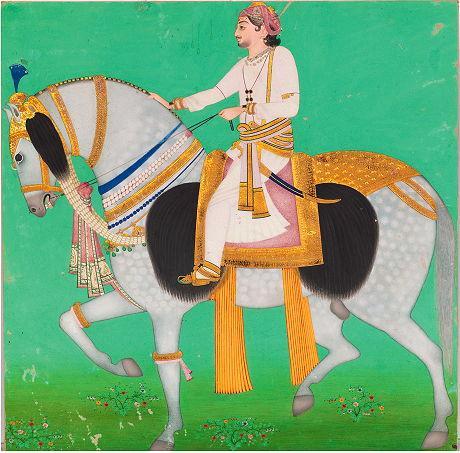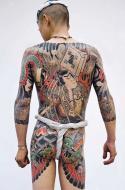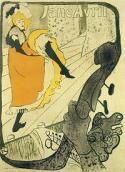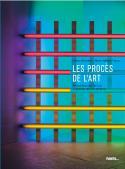Art Of The Day Weekly
#344 - from 1 May 2014 to 7 May 2014

Equestrian portrait of the Maharao Sheodan Singh of Alwar. India, Rajasthan, Alwar, circa 1863. Gouache and watercolour, with gold highlights, on paper. 21.5cm x 21.5cm LAD.2011.080.© Louvre Abu Dhabi/F Photo Agency
IN THE AIR
Louvre, an Oriental connection
PARIS – The « annex » is only meant to open in December 2015, but the Louvre in Paris is finally giving a pre-show of the Louvre Abu Dhabi. Very few initiatives over the last decades have shaken the world of museums as this one has. The art world –and others- wonder if the Louvre sold its soul for the money it needed to remain autonomous? Did the France Museum agency developed the collection of Abu Dhabi at the cost of other national museums, in a market that is increasingly competitive? Once the museum on the island of Saadiyat has opened, will the loans promised by the Louvre strip the flagship? The nearly 150 works presented will undoubtedly not help erase all these questions, nor answer them. But they will give us a clue on other qualms that come back regularly. Such as the place of the human figure, that of religion, or of nudes. Only one thing is certain when our eyes sweep over the works from Bellini to Yves Klein, including the Ostrogoth fibula and Tang marquetry. The ambition behind it is unlimited.
• Naissance d’un musée, Louvre Abu Dhabi at the musée du Louvre, from 2 May to 28 July 2014.
EXHIBITIONS
Tattoo me!
PARIS – The title could be the words to a sensual jazz song. This fashion, almost unheard of before, has expanded over the last decade. How can we explain that the use of tattoos that were identified to prisoners, to boys of disrepute and to sailors from distant lands, has had such success in our Western society? This international and transversal exhibition tries to answer this question by putting side-by-side communities that are not used to rubbing elbows. This can mean circus freaks from the Middle West, Thai bowers, Maori dignitaries or Iroquois warriors. From the Japanese pioneers of the Edo period in the 17th century to the frightening members of the Central American maras, this wide array is shown through hyper realistic molds of human body parts and by the most contemporary creations.
• Tatoueurs, tatoués at the musée du quai Branly, from 2 May to 28 July 2014.
Whistler-on-Thames
WASHINGTON – James Whistler, the head of the American impressionists, was hardly more than twenty years old when he came to the old continent. Rather than settling in Paris, as the more ambitious artists would do, he chose London. And he befriended local intellectuals such as Oscar Wilde. He was fascinated by the changing harmonies of the Thames and by its urban environment, which he immortalized in a great number of his compositions.
• An American in London: Whistler and the Thames at the Arthur M. Sackler Gallery, from 3 May to 17 August 2014.
Toulouse-Lautrec, a Hungarian star
BUDAPEST - The museum of Fine Arts of the Hungarian capital owns an important collection of nearly 170 lithographs by Toulouse-Lautrec, done between 1891 and 1901. A selection of them is being shown for the first time since 1964, together with the painting the museum owns, Ces dames au réfectoire.
• Toulouse-Lautrec, prints and lithographs at the Szepmuveszeti Museum, from 30 April to 25 August 2014.
Do have a wedding!
LONDON - Margaret Wigham, the duchess of Argyll,wore a sumptuous creation by Norman Hartnell when she married for the first time in 1933. Wendy Ramshaw, a jewelry designer, designed her own dress in 1962. And what did brides wear at the end of the 18th century? And today? The exhibition covers two and a half centuries of wedding dresses.
• Wedding Dresses, 1775-2014 at the Victoria & Albert Museum, from 3 May 2014 to 15 March 2015.
ARTIST OF THE WEEK
Moscona, looking out for Argentine society
He is a wonderboy of contemporary art who has no time to waste. Born in 1979, Sergio Moscona has already had two retrospectives at the Sivori museum in Buenos Aires. His characters, drawn in one definite line as if with a surgeon’s knife, are a social theatre that is not the simple reflection of his imagination: it reflects the working classes from Southern Argentina, between repression, slums and drug abuse, a mix between kids off the street and cartoneros, the ragmen of our times. Inspired by his elders, such as Antonio Berni or Antonio Segui, but with a more “expressionist” touch, Moscona draws a pitiless portrait of an unjust and individualistic society.
• Sergio Moscona, Paquito Laguna at the galerie Claire Corcia, from 3 April to 31 May 2014.
OPENINGS OF THE WEEK
AUCTIONS
Picasso in earth
LONDON – Picasso discovered a great passion for ceramics in the later part of his life, when he left Paris to go live definitely in Southern France, at the end of World War II. He cultivated this passion until his death. It was also his interest in ceramics that helped him met his last companion, Jacqueline Roque. She worked at her cousins’, the Ramié family, the owners in Vallauris of what would become the famous Madoura house. Owls, doves, goats, picadors and bullfights were his favorite subjects. A multiple work by Picasso can cost as much as a single work of art by other artists. A pitcher Visage aux yeux rieurs, made in 1969 and produced in 350 copies, is estimated at €12,000. With a budget of approximately €1000 €, a buyer will have to make do with an exhibition poster.
• Important Ceramics by Picasso at Sotheby’s on 7 May 2014.
BOOKS
Art and the courts
In these times of generalized permissiveness, can an artist paint, draw or sculpt whatever he well pleases? Not at all, as this book clearly proves. While morality is no longer defended as strongly, other faults that were rarely criticized have become a gold mine for litigations: the offence against copyright, the defense of racism, of anti-Semitism, of pedophiles, the promotion of hatred, of suicide or to use drugs. Through a series of examples with comments, which show buyers who have been ripped off, Catholic associations or heirs in conflict, we can measure the variety of sources of litigation and their evolution through time. A Whistler painted in 1893 and which was never delivered, a so-called portrait of Sarah Bernhardt by an unknown master, a refrigerator decorated by Bernard Buffet, a work by Magritte and a record cover of the Rolling Stones: each case can be seen as a mini-mystery.
• Les procès de l’art, par Céline Delavaux et Marie-Hélène Vignes, Palette…, 2013, 352 p., €29.90.







